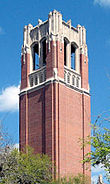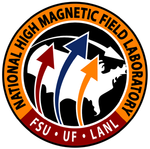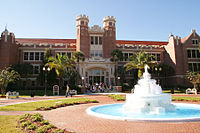- National High Magnetic Field Laboratory
-
the National High Magnetic Field Laboratory (NHMFL) is a laboratory at Florida State University, with branches in University of Florida and at Los Alamos National Laboratory. NHMFL develops and research at magnetic fields for research in physics, biology, bioengineering, chemistry, geochemistry, biochemistry. The world's highest powered magnet laboratory, it is the only facility of its kind in the United States,[1] among nine[citation needed] worldwide. The lab is supported by the National Science Foundation and the state of Florida, and works in collaboration with private industry.
Contents
History
Proposal and award
In 1989 Florida State University (FSU), Los Alamos National Laboratory, and the University of Florida submitted a proposal to the National Science Foundation (NSF) for a new national laboratory supporting interdisciplinary research in high magnetic fields. The plan proposed a federal-state partnership serving magnet-related research, science and technology education, and partnering industry. The goal was to maintain the competitive position of the United States in magnet-related research and development. Following a peer-review competition, the NSF approved the FSU-led consortium's proposal.
Competing proposal by MIT
In a competing proposal to the NSF, the Massachusetts Institute of Technology (MIT), with the University of Iowa, the University of Wisconsin–Madison, Brookhaven National Laboratory, and Argonne National Laboratory, had suggested improving the existing world-class Francis Bitter Magnet Laboratory at MIT instead. On September 5, 1990, MIT researchers asked the 21 members of the National Science Board (NSB) to "review and reconsider" its decision.[2] With $60 million at stake in the NSF grant, MIT stated it would phase out the Francis Bitter Lab if it lost its appeal, the first of its kind in NSF history. The request was turned down September 18, 1990.[3]
Early years
The laboratory's early years were spent establishing infrastructure, building the facility, and recruiting faculty. The Tallahassee complex was dedicated on October 1, 1994, to a large crowd, with keynote speaker Vice President Al Gore.
Mission
The lab's mission, as set forth by the NSF, is: "To provide the highest magnetic fields and necessary services for scientific research conducted by users from a wide range of disciplines, including physics, chemistry, materials science, engineering, biology and geology."
The lab focuses on four objectives:
- Develop user facilities and services for magnet-related research, open to all qualified scientists and engineers
- Advance magnet technology in cooperation with industry
- Promote a multidisciplinary research environment and administer in-house research program that uses and advances the facilities
- Develop an educational outreach program
Education and Public Outreach
The Magnet Lab promotes science education and supports science, engineering, and science teachers. Programs include mentorships in an interdisciplinary learning environment. Through Mag Lab U,[4] the lab's web site provides educational content on electricity and magnetism in general, and the work done at the Magnet Lab in particular.
Programs
Florida State University Programs
The Tallahassee laboratory at Florida State University is a 34,374 square meter (370,000 sq ft.) complex and has approximately 300 faculty, staff, graduate, and postdoctoral students. Its director is physicist Gregory Scott Boebinger.
DC Field Program
The purpose of the DC (continuous field) field program is to provide to the user community with the strongest, quietest, steady and slowly varying magnetic fields in the world, coupled with state-of-the-art instrumentation and experimental expertise.
The facility contains 14 resistive magnet cells connected to a newly upgraded 48 megawatt DC power supply and 15,000 square feet (1,400 m2) of cooling equipment to remove the heat generated by the magnets. The research is supported by magnet plant and cryogenic system operators. Technicians design, build and repair instruments for user research. Scholar-scientists — world-class researchers with their own vibrant research interests — work directly with users to get the best measurements and data.
The facility houses several world-record magnets, including the 45 tesla hybrid magnet, which combines resistive and superconducting magnets to create the strongest steady magnetic field available anywhere. The lab's 35 tesla resistive magnet is the strongest resistive magnet in the world, and the 25 tesla Keck magnet boasts the highest homogeneity of any resistive magnet.
Future plans are in place to build a second hybrid magnet that can reach a magnitude of 55 to 60 teslas, using a similar system of resistive and superconducting magnets. It is hoped that due to current research into superconductivity and other advances that this goal may soon be reached, but there is no official word on a construction time table. To see a video of the current 45 tesla hybrid magnet, click here.
NMR Spectroscopy and Imaging Program
This program serves a broad user base in solution and solid state NMR spectroscopy and MRI and diffusion measurements at the highest possible magnetic field strengths. The lab develops technology, methodology, and applications at high magnetic fields through both in-house and external user activities. It has experienced research faculty, engineers, and technicians spanning these disciplines who are available to facilitate user activities on a wide range of unique equipment and to develop novel experiments and new instrumentation. The program's flagship magnet is the Mag Lab-made 900 MHz (21.1 tesla) NMR magnet. With an ultra-wide bore measuring 105 mm (about 4 inches) in diameter, this superconducting magnet offers the highest field for an MRI study of a living animal in the world.
Ion Cyclotron Resonance Program
This program is charged with developing and exploiting the unique capabilities of FT-ICR (Fourier Transform Ion Cyclotron Resonance) mass spectrometry. The ICR program leads the world in instrument and technique development as well as pursuing novel applications of FT-ICR mass spectrometry. Under the leadership of director Alan G. Marshall, the program continuously develops techniques and instruments and pursues novel applications of FT-ICR mass spectrometry. The program features several instruments, including the 14.5 tesla, 104 mm bore system, the highest-field superconducting ICR magnet in the world.
Electron Magnetic Resonance Program
The most common form of EMR is electron paramagnetic/spin resonance (EPR/ESR). In EPR experiments, transitions are observed between the mS sublevels of an electronic spin state S that are split by the applied magnetic field as well as by the fine structure interactions and the electron-nuclear hyperfine interactions. This technique has extensive applications in chemistry, biochemistry, biology, physics and materials research.
Magnet Science and Technology
The Magnet Science and Technology division is charged with developing the technology and expertise for cutting-edge magnet systems. These magnet projects include building advanced magnet systems for the Tallahassee and Los Alamos sites, working with industry to develop the technology to improve high-field magnet manufacturing capabilities, and pushing the state of the art beyond what is currently available in high field magnet systems through research and development.
Also at the lab's FSU headquarters, the Applied Superconductivity Center advances the science and technology of superconductivity by understanding and pushing the limits of both the low temperature niobium-based and the high temperature cuprate or MgB2-based materials. Focusing heavily on understanding and exploiting the interface between the “R” and the “D” in R&D, the ASC pursues the superconductors needed for everything from magnets for fusion, high energy physics, MRI, to electric power transmission lines and transformers.
In-House Research
An in-house research program flourishes at the Magnet Lab. The program utilizes Magnet Lab facilities to pursue high field research at the forefront of science and engineering, while advancing the lab’s user programs through development of new techniques and equipments.
Condensed Matter Group
The Condensed Matter Group scientists concentrate on various aspects of condensed matter physics, including studies and experiments involving magnetism, the quantum hall effect, quantum oscillations, high temperature superconductivity, and heavy fermion systems.
Geochemistry Program
The geochemistry research program is centered around the use of trace elements and isotopes to understand the Earth processes and environment. The research interests range from the chemical evolution of Earth and solar system through time to local scale problems on the sources and transport of environmentally significant substances. The studies conducted by the geochemistry division concern terrestrial and extraterrestrial questions and involve land-based and sea-going expeditions and spacecraft missions. Together with FSU's Chemistry and Oceanography departments, Geochemistry has started a program in Biogeochemical Dynamics.
Other Programs
The lab’s long-range planning includes enhancements to user programs, both for high field research and related fields. Various affiliated programs complement and help extend the capabilities of existing programs. These include cryogenics, optical microscopy, quantum materials and resonant ultrasound spectroscopy.
Los Alamos National Laboratory - The Pulsed Field Facility
Los Alamos National Laboratory in New Mexico hosts the Pulsed Field Facility, which provides researchers with experimental capabilities for a wide range of measurements in non-destructive pulsed fields to 60 teslas. Pulsed field magnets create very high magnetic fields, but only for fractions of a second. A 100 tesla multi-shot magnet is being jointly constructed by the Department of Energy and the National Science Foundation. The laboratory is located at the center of Los Alamos. In 1999-2000, the facility was relocated into a new specially designed Experimental Hall to better accommodate user operations and support. The program is an integral component of the Magnet Lab and continues to be the first and only high pulsed field user facility in the United States. The laboratory is dedicated to driving pulsed magnetic field technology and instrumentation and to make research using pulsed magnetic fields available to scientists from the United States and around the world.
The facility provides a wide variety of experimental capabilities to 60 teslas, using short and long pulse magnets. Power comes from a pulsed power infrastructure which includes a 1.43 gigawatt motor generator and five 64-megawatt power supplies. The 1200-ton motor generator sits on a 4800-short ton (4350 t) inertia block which rests on 60 springs to minimize earth tremors is the centerpiece of the Pulsed Field Laboratory.
The facility's magnets include a 60 tesla long-pulse magnet that is the most powerful controlled-pulse magnet in the world.
University of Florida Programs
The University of Florida is home to user facilities in magnetic resonance imaging or (MRI) with an ultra-low temperature, ultra-quiet environment for experimental studies in the High B/T (high magnetic field/low temperature) Facility. Facilities are also available for the fabrication and characterization of nanostructures at a new Nanoscale Research Facility being operated in conjunction with the university's Major Analytical and Instrumentation Center.
High B/T Facility
The High B/T Facility is operated as part of the Microkelvin Laboratory of the Physics Department. The facility is designed to meet the needs of Magnet Lab users who wish to conduct experiments in high magnetic fields up to 15.2 teslas and at temperatures as low as 0.4 mK simultaneously. Faculty members in the facility work with users in the design of experiments where needed. Instrumentation is available for studies of magnetization, thermodynamic quantities, transport measurements, magnetic resonance, viscosity, diffusion, and pressure.
The facility holds world records for high B/T in Bay 1 for short term low field capabilities and world records for high field long time (> 1 week) experiments. The research group leads the world in collective studies of quantum fluids and solids in terms of breadth and low temperature techniques (thermometry, NMR, ultrasound, heat capacity, sample cooling.)
Advanced Magnetic Resonance Imaging and Spectroscopy
The Advanced Magnetic Resonance Imaging and Spectroscopy program (AMRIS) contains facilities for the Mag Lab's NMR Program that complement the facilities at the lab's headquarters in Tallahassee. AMRIS is located at the University of Florida's McKnight Brain Institute. Their instruments include the 600 MHz NMR Magnet with 1 mm Triple-Resonance, High-Temperature Superconducting Probe, which delivers the highest mass sensitivity of any probe at any frequency in the world.
References
- ^ "National Science Foundation Supported Research Infrastructure". National Science Foundation. p. 66. http://www.nsf.gov/news/nsf09013/nsf_09013.pdf.
- ^ MIT Asks National Science Board To Reconsider Magnet Lab Vote. . MIT Tech Talk (MIT News Office). http://web.mit.edu/newsoffice/tt/90/sep12/23617.html.[dead link]
- ^ "NSF denies MIT appeal". The Tech (Online Edition). http://tech.mit.edu/V110/N35/magnet.35n.html. Retrieved 2009-08-26.
- ^ http://www.magnet.fsu.edu/education/tutorials/
External links
- National High Magnetic Field Laboratory, Florida State University
- Pulsed Field Facility, Los Alamos National Laboratory
- High B/T Facility, University of Florida
- Advanced Magnetic Resonance Imaging and Spectroscopy Facility, (AMRIS), University of Florida
University of Florida Academics Colleges: Agricultural and Life Sciences · Dentistry · Design, Construction and Planning · Education · Engineering · Fine Arts · Fisher School of Accounting · Health and Human Performance · Journalism and Communications · Levin College of Law · Liberal Arts and Sciences · Medicine · Medicine-Jacksonville · Nursing · Pharmacy · Public Health and Health Professions · Rinker School of Building Construction · Veterinary Medicine · Warrington College of Business Administration
Other units: Bob Graham Center for Public Service · Continuing Education · International Center
Sports Overview: Florida Gators
Teams: Baseball · Men's basketball · Women's basketball · Cross country · Football · Men's golf · Women's golf · Women's gymnastics · Women's lacrosse · Women's soccer · Softball · Swimming and diving · Men's tennis · Women's tennis · Track and field · Women's volleyball
Conferences: Southeastern Conference · American Lacrosse ConferenceResearch Gatorade · J. Hillis Miller Health Science Center · George A. Smathers Libraries · Digital Collection · McKnight Brain Institute · Shands at the University of Florida · Cancer Hospital · Shands Jacksonville · UF Training Reactor · MacroCenter · Cancer and Genetics Research Complex · Mag Lab · Sanford-Burnham Institute · Moffitt Cancer Center & Research Institute · Gran Telescopio Canarias · Institute of Food and Agricultural Sciences · Bridge Software Institute · P.K. Yonge Research School · Whitney Marine Lab · Trusopt · Sid Martin Biotechnology Incubator · Emerging Pathogens Institute · Askew Institute · Florida Institute for Sustainable EnergyPeople Alumni · Board of Trustees · University Presidents · Faculty and administrators · Honorary degree recipients · Alumni Association · Investment CorporationCulture History of the University of Florida · Gator Chomp · Albert and Alberta · "We Are the Boys" · "The Orange and Blue" · Hillel at UF · Theatre Strike Force · Marching Band · Gatorettes · Mr. Two Bits · Dazzlers · Fraternities and sororities · Florida Blue Key · Gator Growl · Miss University of Florida · ACCENT Speakers Bureau · University of Florida ROTC · Progressive Black Journalists · Ligature Design Symposium · Alec Courtelis Award · 34th Street Wall · Florida Opportunity Scholars Program · President's House · UF in popular culture · Gator Wrap RingMedia The Independent Florida Alligator · Subtropics · WUFT TV · WUFT FM / WJUF · WRUF AM · WRUF FM · WRUF LD · Old WRUF Radio Station · University of Florida PressCampus List of Buildings · Century Tower · Plaza of the Americas · Southwest Recreation Center · Student housing · J. Wayne Reitz Union · Constans Theatre · University Auditorium · Phillips Center for the Performing Arts · Samuel P. Harn Museum of Art · Museum of Natural History · Baughman Center · The Hub · University of Florida Campus Historic District · Murphree Area · Yulee Area · Florida Gymnasium · Lake Alice · Cooperative Living Organization · RTS Campus ServiceUniversity of Florida • Gainesville, Florida
Coordinates: 30°25′31″N 84°19′15″W / 30.425215°N 84.320915°WCategories:- Florida State University
- Nuclear research centers
- Particle physics facilities
- Research institutes in the United States
- National Science Foundation
- United States Department of Energy National Laboratories
Wikimedia Foundation. 2010.






